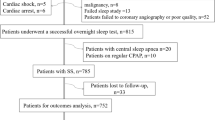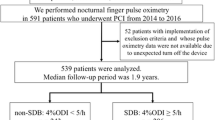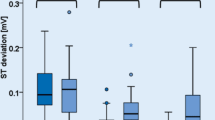Abstract
Purpose
The negative association between obstructive sleep apnea (OSA) and adverse cardiovascular outcomes in patients undergoing percutaneous coronary intervention (PCI) is well documented. However, little is known about the influence of OSA on fibrinolytic therapy. The aim of this study was to evaluate the impact of severe OSA on pharmacoinvasive treatment in ST elevation myocardial infarction (STEMI) patients.
Methods
We enrolled consecutive STEMI patients without previous vascular disease, heart failure, or OSA diagnosis. All patients underwent either a pharmacoinvasive therapy or primary PCI. Syntax score (SS) was calculated for all patients, and a full bedside polysomnography was performed in the first 72 h of admission. In-hospital events and 30 days readmissions were analyzed.
Results
The sample included 116 patients, 87 men. Patients with severe OSA were older (p = 0.01), had higher neck and abdominal circumferences (p < 0.01), and had higher BMI (p < 0.01). They also had lower reperfusion rates post-fibrinolysis (20 vs. 65%; p = 0.001), higher SS (20.2 ± 11.2 vs. 14.6 ± 10.6; p = 0.03), lower left ventricle ejection fraction (45 ± 8 vs. 51 ± 10%; p = 0.02), and a higher incidence of atrial arrhythmias (4 vs. 21%; p = 0.02). STEMI patients with severe OSA presented with threefold increase in the risk for at least one adverse outcome. Regression analysis showed that both severe OSA and hypertension were independent predictors of higher SS.
Conclusion
Severe OSA was associated with a poor outcome after pharmacoinvasive treatment in STEMI patients.
Similar content being viewed by others
References
Franklin KA, Lindberg E (2015) Obstructive sleep apnea is a common disorder in the population—a review on the epidemiology of sleep apnea. J Thorac Dis 7(8):1311–1322
Cai A, Zhou Y, Zhang J, Zhong Q, Wang R, Wang L (2017) Epidemiological characteristics and gender-specific differences of obstructive sleep apnea in a Chinese hypertensive population: a cross-sectional study. BMC Cardiovasc Disord 17(1):1–7
Pearse SG, Cowie MR (2016) Sleep-disordered breathing in heart failure. Eur J Heart Fail 18(4):353–361
Zhang L, Hou Y, Po SS (2015) Obstructive sleep apnoea and atrial fibrillation. Arrhythm Electrophysiol Rev 4(1):14–18
Lipford MC, Flemming KD, Calvin AD, Mandrekar J, Brown RD Jr, Somers VK, Caples SM (2015) Associations between cardioembolic stroke and obstructive sleep apnea. Sleep 38(11):1699–1705
Sorajja D, Gami AS, Somers VK, Behrenbeck TR, Garcia-Touchard A, Lopez-Jimenez F (2008) Independent association between obstructive sleep apnea and subclinical coronary artery disease. Chest 133(4):927–933
Gami AS, Olson EJ, Shen WK, Wright RS, Ballman KV, Hodge DO, Herges RM, Howard DE, Somers VK (2013) Obstructive sleep apnea and the risk of sudden cardiac death: a longitudinal study of 10,701 adults. J Am Coll Cardiol 62(7):610–616
Marin JM, Carrizo SJ, Vicente E, Agusti AG (2005) Long-term cardiovascular outcomes in men with obstructive sleep apnoea-hypopnoea with or without treatment with continuous positive airway pressure: an observational study. Lancet 365(9464):1046–1053
Benjamin EJ, Virani SS, Callaway CW, Chamberlain AM, Chang AR, Cheng S, Chiuve SE, Cushman M, Delling FN, Deo R, de Ferranti SD, Ferguson JF, Fornage M, Gillespie C, Isasi CR, Jiménez MC, Jordan LC, Judd SE, Lackland D, Lichtman JH, Lisabeth L, Liu S, Longenecker CT, Lutsey PL, Mackey JS, Matchar DB, Matsushita K, Mussolino ME, Nasir K, O’Flaherty M, Palaniappan LP, Pandey A, Pandey DK, Reeves MJ, Ritchey MD, Rodriguez CJ, Roth GA, Rosamond WD, UKA S, Satou GM, Shah SH, Spartano NL, Tirschwell DL, Tsao CW, Voeks JH, Willey JZ, Wilkins JT, Wu JH, Alger HM, Wong SS, Muntner P, American Heart Association Council on Epidemiology and Prevention, Statistics Committee and Stroke Statistics Subcommittee (2018) Heart disease and stroke statistics-2018 update: a report from the American Heart Association. Circulation 137(12):e67–e492
Lee CH, Khoo SM, Chan MY, Wong HB, Low AF, Phua QH, Richards AM, Tan HC, Yeo TC (2011) Severe obstructive sleep apnea and outcomes following myocardial infarction. J Clin Sleep Med 7(6):616–621
Pinto DS, Kirtane AJ, Nallamothu BK, Murphy SA, Cohen DJ, Laham RJ, Cutlip DE, Bates ER, Frederick PD, Miller DP, Carrozza JP, Antman EM, Cannon CP, Gibson CM (2006) Hospital delays in reperfusion for ST-elevation myocardial infarction: implications when selecting a reperfusion strategy. Circulation 114(19):2019–2025
Pinto DS, Frederick PD, Chakrabarti AK, Kirtane AJ, Ullman E, Dejam A, Miller DP, Henry TD, Gibson CM (2011) National registry of myocardial infarction investigators. Benefit of transferring ST-segment-elevation myocardial infarction patients for percutaneous coronary intervention compared with administration of onsite fibrinolytic declines as delays increase. Circulation 124(23):2512–2521
Rashid MK, Guron N, Bernick J, Wells GA, Blondeau M, Chong AY, Dick A, Froeschl MP, Glover CA, Hibbert B, Labinaz M, Marquis JF, Osborne C, So DY, Le May MR (2016) Safety and efficacy of a pharmacoinvasive strategy in ST-segment elevation myocardial infarction: a patient population study comparing a pharmacoinvasive strategy with a primary percutaneous coronary intervention strategy within a regional system. JACC Cardiovasc Interv 9(19):2014–2020.
von Känel R, Dimsdale JE (2003) Hemostatic alterations in patients with obstructive sleep apnea and the implications for cardiovascular disease. Chest 124(11):1956–1967
Liak C, Fitzpatrick M (2011) Coagulability in obstructive sleep apnea. Can Respir J 18:338–348
Wessendorf TE, Thilmann AF, Wang YM, Schreiber A, Konietzko N, Teschler H (2000) Fibrinogenlevels and obstructive sleep apnea in ischemic stroke. Am J Respir Crit Care Med 162:2039–2042
Shitrit D, Peled N, Shitrit AB, Meidan S, Bendayan D, Sahar G, Kramer MR (2005) An association between oxygen desaturation and D-dimer in patients with obstructive sleep apnea syndrome. Thromb Haemost 94:544–547
von Kanel R, Loredo JS, Ancoli-Israel S et al (2007) Association between polysomnographic measures of disrupted sleep and prothrombotic factors. Chest 131:733–739
Qu H, Guo M, Zhang Y, Shi DZ (2018) Obstructive sleep apnea increases the risk of cardiac events after percutaneous coronary intervention: a meta-analysis of prospective cohort studies. Sleep Breath 22(1):33–40
Ibanez B, James S, Agewall S, Antunes MJ, Bucciarelli-Ducci C, Bueno H, Caforio ALP, Crea F, Goudevenos JA, Halvorsen S, Hindricks G, Kastrati A, Lenzen MJ, Prescott E, Roffi M, Valgimigli M, Varenhorst C, Vranckx P, Widimský P, ESC Scientific Document Group (2018) 2017 ESC Guidelines for the management of acute myocardial infarction in patients presenting with ST-segment elevation: the Task Force for the management of acute myocardial infarction in patients presenting with ST-segment elevation of the European Society of Cardiology (ESC). Eur Heart J 39(2):119–177
Sianos G, Morel MA, Kappetein AP, Morice MC, Colombo A, Dawkins K, van den Brand M, Van Dyck N, Russell ME, Mohr FW, Serruys PW (2005) The SYNTAX score angiographic tool grading the complexity of coronary artery disease. Eur Intervention 1(2):219–227
Iber C, Ancoli-Israel S, Chesson A, Quan SF (2007) The AASM manual for the scoring of sleep and associated events: rules, terminology and technical specifications, 1st edn. American Academy of Sleep Medicine, Westchester, IL
Kwon Y, Duprez DA, Jacobs DR, Nagayoshi M, McClelland RL, Shahar E, Budoff M, Redline S, Shea S, Carr JJ, Lutsey PL (2014) Obstructive sleep apnea and progression of coronary artery calcium: the multi-ethnic study of atherosclerosis study. J am heart Assoc 3(5):e001241
Barceló A, Piérola J, de la Peña M et al (2012) Day–night variations in endothelial dysfunction markers and haemostatic factors in sleep apnoea. Eur Respir J 39:913–918
Zakrzewski M, Zakrzewska E, Kiciński P, Przybylska-Kuć S, Dybała A, Myśliński W, Pastryk J, Tomaszewski T, Mosiewicz J (2016) Evaluation of fibrinolytic inhibitors: alpha-2-antiplasmin and plasminogen activator inhibitor 1 in patients with obstructive sleep apnoea. PLoS ONE 11(11):e0166725
O’Gara PT, Kushner FG, Ascheim DD et al (2013) 2013 ACCF/AHA guideline for the management of ST-elevation myocardial infarction: a report of the American College of Cardiology Foundation/American Heart Association Task Force on Practice Guidelines. J Am Coll Cardiol (61(4):78–140
Nakashima H, Katayama T, Takagi C, Amenomori K, Ishizaki M, Honda Y, Suzuki S (2006) Obstructive sleep apnoea inhibits the recovery of left ventricular function in patients with acute myocardial infarction. Eur Heart J 27(19):2317–2322
Jia S, Zhou YJ, Yu Y, Wu SJ, Sun Y, Wang ZJ, Liu XL, King BE, Zhao YX, Shi DM, Liu YY, Zhou ZM (2018) Obstructive sleep apnea is associated with severity and long-term prognosis of acute coronary syndrome. J Geriatr Cardiol 15(2):146–152
Hein T, Loo G, Ng WY, Tai BC, Kajiya T, Tan A, Khoo SM, Chan M, Low AF, Chia BL, Richards M, Lee CH (2013) Relationship between apnoea-hypopnoea index and angiographic coronary disease phenotypes in patients presenting with acute myocardial infarction. Acute Card Care 15(2):26–33
Youssef I, Kamran H, Yacoub M, Patel N, Goulbourne C, Kumar S, Kane J, Hoffner H, Salifu M, McFarlane SI (2018) Obstructive sleep apnea as a risk factor for atrial fibrillation: a meta-analysis. J Sleep Disord Ther 7(1):1–10
Mazza A, Bendini MG, Cristofori M, Nardi S, Leggio M, De Cristofaro R, Giordano A, Cozzari L, Giordano G, Cappato R (2009) Baseline apnoea/hypopnoea index and high-sensitivity C-reactive protein for the risk of recurrence of atrial fibrillation after successful electrical cardioversion: a predictive model based upon the multiple effects of significant variables. Europace 11(7):902–909
Deng F, Raza A, Guo J (2018) Treating obstructive sleep apnea with continuous positive airway pressure reduces risk of recurrent atrial fibrillation after catheter ablation: a meta-analysis. Sleep Med 46:5–11
Acknowledgments
This study was supported by the Associação Fundo de Incentivo à Pesquisa (AFIP), which provided personnel and the polysomnographic systems used during data collection.
Funding
This study was funded by the Associação Fundo de Pesquisa em psicofarmacologia (AFIP/2016).
Author information
Authors and Affiliations
Corresponding author
Ethics declarations
Conflict of interest
The authors declare that they have no conflict of interest.
Ethical approval
All procedures performed in studies involving human participants were in accordance with the ethical standards of the institutional and/or national research committee and with the 1964 Helsinki declaration and its later amendments or comparable ethical standards. Informed consent was obtained from all individual participants included in the study.
Additional information
Publisher’s note
Springer Nature remains neutral with regard to jurisdictional claims in published maps and institutional affiliations.
Rights and permissions
About this article
Cite this article
Maroja, F., Caixeta, A., Poyares, D. et al. Impact of severe OSA on pharmacoinvasive treatment in ST elevation myocardial infarction patients. Sleep Breath 24, 1357–1363 (2020). https://doi.org/10.1007/s11325-019-01975-4
Received:
Revised:
Accepted:
Published:
Issue Date:
DOI: https://doi.org/10.1007/s11325-019-01975-4




